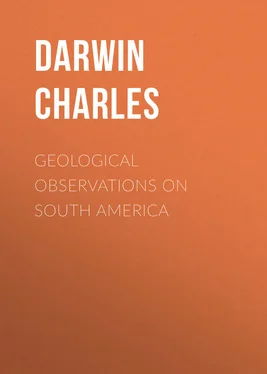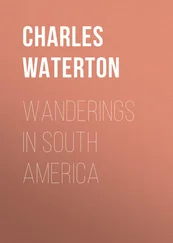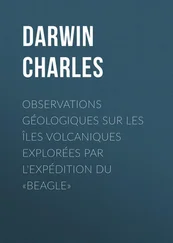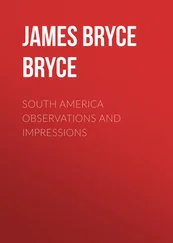Charles Darwin - Geological Observations on South America
Здесь есть возможность читать онлайн «Charles Darwin - Geological Observations on South America» — ознакомительный отрывок электронной книги совершенно бесплатно, а после прочтения отрывка купить полную версию. В некоторых случаях можно слушать аудио, скачать через торрент в формате fb2 и присутствует краткое содержание. Жанр: foreign_antique, foreign_prose, на английском языке. Описание произведения, (предисловие) а так же отзывы посетителей доступны на портале библиотеки ЛибКат.
- Название:Geological Observations on South America
- Автор:
- Жанр:
- Год:неизвестен
- ISBN:нет данных
- Рейтинг книги:3 / 5. Голосов: 1
-
Избранное:Добавить в избранное
- Отзывы:
-
Ваша оценка:
- 60
- 1
- 2
- 3
- 4
- 5
Geological Observations on South America: краткое содержание, описание и аннотация
Предлагаем к чтению аннотацию, описание, краткое содержание или предисловие (зависит от того, что написал сам автор книги «Geological Observations on South America»). Если вы не нашли необходимую информацию о книге — напишите в комментариях, мы постараемся отыскать её.
Geological Observations on South America — читать онлайн ознакомительный отрывок
Ниже представлен текст книги, разбитый по страницам. Система сохранения места последней прочитанной страницы, позволяет с удобством читать онлайн бесплатно книгу «Geological Observations on South America», без необходимости каждый раз заново искать на чём Вы остановились. Поставьте закладку, и сможете в любой момент перейти на страницу, на которой закончили чтение.
Интервал:
Закладка:
LIMA.
Northward of Arica, I know nothing of the coast for about a space of five degrees of latitude; but near Callao, the port of Lima, there is abundant and very curious evidence of the elevation of the land. The island of San Lorenzo is upwards of one thousand feet high; the basset edges of the strata composing the lower part are worn into three obscure, narrow, sloping steps or ledges, which can be seen only when standing on them: they probably resemble those described by Lieutenant Freyer at Arica. The surface of the lower ledge, which extends from a low cliff overhanging the sea to the foot of the next upper escarpment, is covered by an enormous accumulation of recent shells. (M. Chevalier, in the "Voyage of the 'Bonite'" observed these shells; but his specimens were lost. – "L'Institut" 1838 page 151.) The bed is level, and in some parts more than two feet in thickness; I traced it over a space of one mile in length, and heard of it in other places: the uppermost part is eighty-five feet by the barometer above high-water mark. The shells are packed together, but not stratified: they are mingled with earth and stones, and are generally covered by a few inches of detritus; they rest on a mass of nearly angular fragments of the underlying sandstone, sometimes cemented together by common salt. I collected eighteen species of shells of all ages and sizes. Several of the univalves had evidently long lain dead at the bottom of the sea, for their INSIDES were incrusted with Balani and Serpulae. All, according to Mr. G.B. Sowerby, are recent species: they consist of: —
1. Mytilus Magellanicus: same as that found at Valparaiso, and there stated to be probably distinct from the true M. Magellanicus of the east coast.
2. Venus costellata, Sowerby "Zoological Proceedings."
3. Pecten purpuratus, Lam.
4. Chama, probably echinulata, Brod.
5. Calyptraea Byronensis, Gray.
6. Calyptraea radians (Trochus, Lam.)
7. Fissurella affinis, Gray.
8. Fissurella biradiata, Trembly.
9. Purpura chocolatta, Duclos.
10. Purpura Peruviana, Gray.
11. Purpura labiata, Gray.
12. Purpura buxea (Murex, Brod.).
13. Concholepas Peruviana.
14. Nassa, related to reticulata.
15. Triton rudis, Brod.
16. Trochus, not yet described, but well-known and very common.
17 and 18. Balanus, two species, both common on the coast.
These upraised shells appear to be nearly in the same proportional numbers-with the exception of the Crepidulae being more numerous – with those on the existing beach. The state of preservation of the different species differed much; but most of them were much corroded, brittle, and bleached: the upper and lower surfaces of the Concholepas had generally quite scaled off: some of the Trochi and Fissurellae still partially retain their colours. It is remarkable that these shells, taken all together, have fully as ancient an appearance, although the extremely arid climate appears highly favourable for their preservation, as those from 1,300 feet at Valparaiso, and certainly a more ancient appearance than those from five to six hundred feet from Valparaiso and Concepcion; at which places I have seen grass and other vegetables actually growing out of the shells. Many of the univalves here at San Lorenzo were filled with, and united together by, pure salt, probably left by the evaporation of the sea-spray, as the land slowly emerged. (The underlying sandstone contains true layers of salt; so that the salt may possibly have come from the beds in the higher parts of the island; but I think more probably from the sea-spray. It is generally asserted that rain never falls on the coast of Peru; but this is not quite accurate; for, on several days, during our visit, the so-called Peruvian dew fell in sufficient quantity to make the streets muddy, and it would certainly have washed so deliquescent a substance as salt into the soil. I state this because M. d'Orbigny, in discussing an analogous subject, supposes that I had forgotten that it never rains on this whole line of coast. See Ulloa's "Voyage" volume 2 English Translation page 67 for an account of the muddy streets of Lima, and on the continuance of the mists during the whole winter. Rain, also, falls at rare intervals even in the driest districts, as, for instance, during forty days, in 1726, at Chocope (7 degrees 46'); this rain entirely ruined ("Ulloa" etc. page 18) the mud houses of the inhabitants.) On the highest parts of the ledge, small fragments of the shells were mingled with, and evidently in process of reduction into, a yellowish-white, soft, calcareous powder, tasting strongly of salt, and in some places as fine as prepared medicinal chalk.
FOSSIL-REMAINS OF HUMAN ART.
In the midst of these shells on San Lorenzo, I found light corallines, the horny ovule-cases of Mollusca, roots of seaweed (Mr. Smith of Jordan Hill found pieces of seaweed in an upraised pleistocene deposit in Scotland. See his admirable Paper in the "Edinburgh New Philosophical Journal" volume 25 page 384.), bones of birds, the heads of Indian corn and other vegetable matter, a piece of woven rushes, and another of nearly decayed COTTON string. I extracted these remains by digging a hole, on a level spot; and they had all indisputably been embedded with the shells. I compared the plaited rush, the COTTON string, and Indian corn, at the house of an antiquary, with similar objects, taken from the Huacas or burial-grounds of the ancient Peruvians, and they were undistinguishable; it should be observed that the Peruvians used string only of cotton. The small quantity of sand or gravel with the shells, the absence of large stones, the width and thickness of the bed, and the time requisite for a ledge to be cut into the sandstone, all show that these remains were not thrown high up by an earthquake-wave: on the other hand, these facts, together with the number of dead shells, and of floating objects, both marine and terrestrial, both natural and human, render it almost certain that they were accumulated on a true beach, since upraised eighty-five feet, and upraised this much since INDIAN MAN INHABITED PERU. The elevation may have been, either by several small sudden starts, or quite gradual; in this latter case the unrolled shells having been thrown up during gales beyond the reach of the waves which afterwards broke on the slowly emerging land. I have made these remarks, chiefly because I was at first surprised at the complete difference in nature, between this broad, smooth, upraised bed of shells, and the present shingle-beach at the foot of the low sandstone-cliffs; but a beach formed, when the sea is cutting into the land, as is shown now to be the case by the low bare sandstone-cliffs, ought not to be compared with a beach accumulated on a gently inclined rocky surface, at a period when the sea (probably owing to the elevatory movement in process) was not able to eat into the land. With respect to the mass of nearly angular, salt- cemented fragments of sandstone, which lie under the shells, and which are so unlike the materials of an ordinary sea-beach; I think it probable after having seen the remarkable effects of the earthquake of 1835 (I have described this in my "Journal of Researches" page 303 2nd edition.), in absolutely shattering as if by gunpowder the SURFACE of the primary rocks near Concepcion, that a smooth bare surface of stone was left by the sea covered by the shelly mass, and that afterwards when upraised, it was superficially shattered by the severe shocks so often experienced here.
The very low land surrounding the town of Callao, is to the south joined by an obscure escarpment to a higher plain (south of Bella Vista), which stretches along the coast for a length of about eight miles. This plain appears to the eye quite level; but the sea-cliffs show that its height varies (as far as I could estimate) from seventy to one hundred and twenty feet. It is composed of thin, sometimes waving, beds of clay, often of bright red and yellow colours, of layers of impure sand, and in one part with a great stratified mass of granitic pebbles. These beds are capped by a remarkable mass, varying from two to six feet in thickness, of reddish loam or mud, containing many scattered and broken fragments of recent marine shells, sometimes though rarely single large round pebble, more frequently short irregular layers of fine gravel, and very many pieces of red coarse earthenware, which from their curvatures must once have formed parts of large vessels. The earthenware is of Indian manufacture; and I found exactly similar pieces accidentally included within the bricks, of which the neighbouring ancient Peruvian burial-mounds are built. These fragments abounded in such numbers in certain spots, that it appeared as if waggon-loads of earthenware had been smashed to pieces. The broken sea- shells and pottery are strewed both on the surface, and throughout the whole thickness of this upper loamy mass. I found them wherever I examined the cliffs, for a space of between two and three miles, and for half a mile inland; and there can be little doubt that this same bed extends with a smooth surface several miles further over the entire plain. Besides the little included irregular layers of small pebbles, there are occasionally very obscure traces of stratification.
Читать дальшеИнтервал:
Закладка:
Похожие книги на «Geological Observations on South America»
Представляем Вашему вниманию похожие книги на «Geological Observations on South America» списком для выбора. Мы отобрали схожую по названию и смыслу литературу в надежде предоставить читателям больше вариантов отыскать новые, интересные, ещё непрочитанные произведения.
Обсуждение, отзывы о книге «Geological Observations on South America» и просто собственные мнения читателей. Оставьте ваши комментарии, напишите, что Вы думаете о произведении, его смысле или главных героях. Укажите что конкретно понравилось, а что нет, и почему Вы так считаете.












